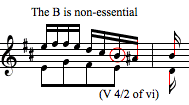An essential tone is one that is part of the prevailing harmony. A non-essential tone
is not part of the prevailing harmony. The distinction between essential and
non-essential tones is important in tonal counterpoint like that of Bach: non-essential tones tend to be treated the same as dissonances,
though strictly speaking they may be consonant. That is why, in tonal counterpoint, "dissonances" are often referred to merely as
"non-chordal tones" or "non-harmonic tones." The devices of passing tone, neighbor tone, suspension, etc. still serve even if technically the
resolution is not always from dissonance to consonance but from not-part-of-the-chord to part-of-the-chord.
The distinction between nonessential and essential plays a part in certain exceptions to the voice-leading "rules" in tonal
counterpoint. For example, in the following passage from Scarlatti cited by Kennen, a parallel fifth
is found acceptable because one of the notes involved is non-essential and therefore doesn't really count. It's an accented passing tone
moving to a note of the prevailing harmony (the A#). But if you think only in terms of intervals as in modal counterpoint the B is not
"dissonant." In the Palestrina style this parallel fifth would not be acceptable.

|
